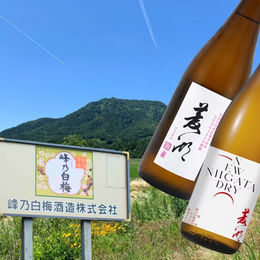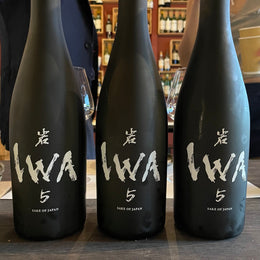
haccoba, yes that's a lower-case "h", has become one of the most exciting Sake brewers in Japan in spite of its youth. In the Sake game, generational expertise is often a great selling point, with many breweries boasting double digit-generations of family members helming the brewery, and therefore conveying a sense of expertise and traditional craftsmanship.
haccoba has none of that - instead it was started in just 2021 by then 29 year old former IT worker Taisuke Sato, who had hoped to combine his fascination with Sake brewing and the ability to help revitalise the Fukushima Prefecture into one.


haccoba's Taisuke Sato.
It's not often you hear of folks wanting to go voluntarily into a nuclear accident site, and yet a number of community-minded young Japanese entrepreneurs are doing just that.
When Sato had read about and met up with a fellow entrepreneur Tomoyuki Wada, he found himself deeply resonating with Wada's ideas on revitalising Odaka in the Fukushima Prefecture which had been unfortunately hurt by numerous events, suffering from an earthquake, a tsunami and then the fateful nuclear disaster in 2011. This forced many of the Odaka's residents to relocate, with the site being cleaned up by environmental safety professionals for 5 years. When the area was reopened, few would enter back in, save for elderly residents who wanted to return to their old life.

“Odaka also exists as a kind of frontier now. Because the residents all had to leave, the life of the town ground to a halt. Livelihoods, culture, everything was gone and now it has to be recultivated,” says Sato.
Drawing back on his time both working part time at a small restaurant where he learnt about how Sakes expressed regional differences, and then working in an Internet startup where he was posted to Ishikawa Prefecture along the shores of the Sea of Japan, which also exposed Sato to the prefecture's many Sake breweries, Sato had thus thought it was perhaps time to finally pursue his dream of being a Sake-maker.
As a fresh graduate, he had initially hoped to be a Sake maker, but quite found out that obtaining a Sake brewing license was difficult unless one's family had already been involved in the business. He would then pursue a career in Tech.

haccoba's young team.
Nevertheless with the likes of Wada and another Sake maker whom he had met that had went on to establish a Sake brewery in Paris, Sato became convinced that this idea was indeed possible. Coupled with the desire to help reinvigorate the community in Odaka, Sato would properly pursue Sake making in 2019.
He first spent time apprenticing at a Niigata Prefecture brewery, and would also come to find his own Sake making sensibilities that aim to pursue new frontiers of what Sake could be. Sato talks of how prior to the late 1800's, Sake was a relatively common homebrew, and yet as a result of a government restriction on homebrewing, techniques from the past were mostly forgotten. One such technique is that of dry-hopping, a concept all too familiar for beer lovers, and yet hops were added to Sakes for the very same reason they were added to beers - to serve as natural preservatives! "Japan used to have a thriving culture of homebrewing, and the hoppy method I use was popular with farmers in Tohoku," says Sato.

haccoba microbrewery.
And so when Sato had found a handful of likeminded young brewers and was able to crowdfund the project, he would first renovate an old farmhouse into a brewery and pub, with the hopes of the venue serving as a place for residents to socialise. Sato believes that with more attractions, Odaka can regain its former liveliness, and that venues such as his can help to create a new sense of community. The first Sake haccoba would brew would indeed be dry-hopped Sakes!
Since then haccoba has found great success with its dry-hopped Hanauta series of Sakes using locally grown rice and Japanese hop varieties, with a blend of yellow and white koji. haccoba would follow up with a LAB_series that turns mundane or unusual food products into Sake expressions, and would go on to collaborate with everything from pastry shops to fragrance brands.

“As we try to develop new ways of making sake, I hope we are able to work together with people in Odaka to bring new life to the town too.”
Sato hopes that other entrepreneurs would join him in their goal of rejuvenating Odaka, which he touts as having the allure of offering cheap and available land, as well as unparalleled flexibility and potential with the chance of getting to build a town from scratch.
As for its name, Sato says that he was inspired by craft beer brewers and wanted his Sakes to evoke a "beer-like" vibe that is typically thought of as more relaxed and friendly compared to most Sake labels. Another aspect of why he chose an English name for his microbrewery has to do with his hopes of not only opening a second brewery in the nearby town of Namie, but to expand into Belgium in 2024.
And so with all that said, it's time to try haccoba's Sake!

Today we've got the Weaving Water - Ai Agri Ota -, third in the Amu Mizu series, it is a dry hopped Sake with hops grown in the Akita Prefecture, and comes with a specific perspective. This expression aims to focus on bringing out the locality and terroir of the rice used in the Sake, which would make it a "local Sake" that conveys the taste of the rice and the way of life of the local farmers.
haccoba says that in the Haramachi Ward of Minamisoma City, where haccoba's microbrewery is in the vicinity of, farmers have begun naturally cultivating Koshihikari rice. However, rather than polishing the rice heavily, which haccoba believes tampers down on the raw and pure characteristics of the rice and its terroir, haccoba instead has polished this minimally (88% rice polishing ratio, so only 12% of the rice is removed) so as to allow it to fully express its natural flavours. This is also brewed together with quince, and reaches an 11% ABV.
Interestingly from a design perspective, the yellow label you see is actually meant to be peeled off via a perforated portion, which would reveal a poem written by the poet Sugawara Satoshi.
Let's give it a go!
haccoba Weaving Water - Ai Agri Ota - | haccoba 水を編む -あいアグリ太田- Review

Tasting Notes
Colour: Cloudy White
Aroma: Really gentle rice pudding sweetness. It's almost alittle powdery, with a really soft sweetness.
Taste: Incredibly (and massively surprising) full-bodied with a deep and rich rice sweetness, the sort from mochi or sweet rice cakes. There's a brightness to its flavour, soft and powdery. Contrasted with the full-bodied Sake, it evokes a sense of elegance. It feels really pure, and for some reason reminiscent of a bed of untouched snow. It's also almost syrupy in texture, with a side of very light savouriness.
Finish: Fades into a light and gentle pure glistening syrupy sweetness. Super deep, concentrated and focused pure sweetness of rice essence. Ends on a very light aromatic floral hop without any bitterness.

My Thoughts
Is this SK-II? Because this is the purest, most focused rice sweetness I have ever tasted in my life. It's soft and powdery in flavour but also rich and with such depth. It almost feels like what you'd get if you soaked rice in water, got out the rice and boiled the rice essence until it becomes an incredibly concentrated syrup. In that sense, it's a flavour that reminds me of Cantonese style congee where the rice grain has completely disintegrated. It's quite hard to describe as you can tell.
Nevertheless, this was incredibly surprising and tasty, it's unlike any Sake I've tasted before and really does make me question the massive focus Sake makers have on ultra high polishing ratios where most of the rice grain is removed to preserve just the the rice core (the shinpachi). This is rich and full of flavour, really singular and distinctive and with such a luminescent elegance that I can only describe as glistening or shimmery. It's so wholly unique, inclusive of that is that final floral kiss of the hops right at the end that just puts the cherry on top.
Wildly tasty! You have to try it! And when you do, please describe it for me, I'll append it here.
Kanpai!

@111hotpot







